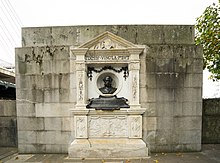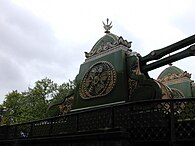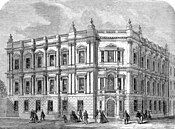Joseph Bazalgette
Sir Joseph Bazalgette | |
|---|---|
 | |
| Born | Joseph William Bazalgette 28 March 1819 |
| Died | 15 March 1891 (aged 71) Wimbledon, Surrey, England |
| Occupation | Civil engineer |
| Children | 10 |

Sir Joseph William Bazalgette
Early life
Bazalgette was born at Hill Lodge,
In 1827, when Joseph was eight years old, the family moved into a newly built house in
In 1845 the house in Hamilton Terrace was sold and Joseph married Maria Kough, from County Kilkenny in Ireland. At the time he was working so hard on expanding the railway network that two years later, in 1847, he suffered a nervous breakdown.
In 1847, while he was recovering, London's Metropolitan Commission of Sewers ordered that all cesspits should be closed and that house drains should connect to sewers and empty into the Thames. A cholera epidemic ensued, killing 14,137 Londoners in 1849.[3][4]
Bazalgette was appointed Assistant Surveyor to the Metropolitan Commission in 1849, taking over as Engineer in 1852 after his predecessor died of "harassing fatigues and anxieties." Soon after, another cholera epidemic struck in 1853, killing 10,738. Medical opinion at the time held that cholera was caused by foul air: a so-called
Championed by fellow engineer
Sewer works


At that time, the River Thames was little more than an open sewer, empty of any fish or other wildlife, and an apparent public health hazard to Londoners.
Bazalgette's solution (similar to a proposal made by painter John Martin 25 years earlier) was to construct a network of 82 miles (132 km) of enclosed underground brick main sewers to intercept sewage outflows, and 1,100 miles (1,800 km) of street sewers, to divert the raw sewage which flowed freely through the streets and thoroughfares of London to the river.
The plan included major
The system was opened by
Partly as a result of the
The basic premise of this expensive project, that miasma spread cholera infection, was wrong. However, the new sewer system's unintended consequence was removing the
Bazalgette's capacity for hard work was remarkable; every connection to the sewerage system by the various Vestry Councils had to be checked, and Bazalgette did this himself, and the records contain thousands of linen plans with handwritten comments in Indian ink on them "Approved JWB", "I do not like 6" used here and 9" should be used. JWB", and so on.[citation needed] Unsurprisingly, his health suffered as a result. Thames Water holds the records in large blue binders gold-blocked reading "Metropolitan Board of Works" and then dated, usually two per year.[citation needed]
Family

Scion of a
Married in 1845, at
- Joseph William, born 20 February 1846
- Charles Norman, born 3 March 1847
- Edward, born 28 June 1848
- Theresa Philo, born 11 August 1850
- Caroline, born 17 July 1852; married George Chatterton
- Maria, born 1854; married Robert Wickham
- Henry, born 14 September 1855
- Willoughby, born 18 March 1857
- Maria Louise, born 1859; died unmarried
- Anna Constance, born 3 December 1859, married Major Frederick Blacker
- Evelyn, born 1 April 1861[10]
Awards and memorials


Knighted in 1875, Bazalgette was elected President of the Institution of Civil Engineers in 1883.[citation needed]
A
Dulwich College has a scholarship in his name either for design and technology or for mathematics and science.[13]

Other works
- Albert Embankment (1869)
- Victoria Embankment (1870)
- Chelsea Embankment (1874)
- Maidstone Bridge (1879)
- Albert Bridge (1884; modifications)
- Putney Bridge (1886)
- Hammersmith Bridge (1887)
- The Woolwich Free Ferry(1889)
- Battersea Bridge (1890)
- Shaftesbury Avenue (1886)
- Early plans for the Blackwall Tunnel (1897)
- Charing Cross Road
- Garrick Street
- Northumberland Avenue
- Proposal for what later became Tower Bridge
Notable descendants
- Will Bazalgette (great-grandson), RCAF pilot awarded the Victoria Cross
- Edward Bazalgette (great-great-grandson), musician and television director
- Sir Peter Bazalgette(great-great-grandson), television producer
Note
- ^ Louis Bazalgette's tailoring account for the Prince Regent (who later became King George IV) was worth over 2 million pounds (adjusted for inflation) and was guaranteed by Parliament.
References
- ISBN 978-0752493787.
- ^ Adonis, Andrew; Parris, Matthew (23 September 2014). "Joseph Bazalgette". BBC Sounds. Great Lives. BBC. Retrieved 29 February 2024.
- ISBN 9781856197168.
- HMSO. p. 146.
- ^ "How the system worked". Crossness Engines. Archived from the original on 2 October 2012.
- ^ CharlotteDunn (30 October 2018). "The Princess Royal visits the Bazalgette Sewer Network". The Royal Family. Retrieved 24 February 2021.
- ^ Mann, Emily (4 April 2016). "Story of cities #14: London's Great Stink heralds a wonder of the industrial world". The Guardian. Retrieved 24 February 2021.
- ^ "'Dirty Old London': A History of the Victorians' Infamous Filth". NPR. 12 March 2015. Archived from the original on 23 June 2017. Retrieved 13 March 2015.
[the famous great sewer network of the mid-19th century] basically took away the possibility of wholesale cholera epidemics in the city, typhus and typhoid – they all were reduced.
- ^ "Obituary – Lady Bazalgette". The Times. No. 36706. London. 4 March 1902. p. 8.
- ^ www.burkespeerage.com
- ^ "Bazalgette, Sir Joseph William (1819–1891)". English Heritage. Archived from the original on 1 August 2011. Retrieved 20 October 2012.
- ^ "Tideway honours Victorian pioneer". The Construction Index. 28 July 2020. Retrieved 28 July 2020.
- ^ The Master's Report to the Governors for the School Year 2004–2005 (PDF) (Report). Dulwich College. p. 7. Archived from the original (PDF) on 17 December 2007.
Further reading
- . Encyclopædia Britannica (11th ed.). 1911.
- Sir Joseph William Bazalgette (1819–1891): Engineer to the Metropolitan Board of Works – D P Smith: Transactions of the Newcomen Society, 1986–87 Vol 58.
- London in the Nineteenth Century: A Human Awful Wonder of God – Jerry White, London: Jonathan Cape 2006.
- The Big Necessity: Adventures in the world of human waste by Rose George, Portobello Books,
- Beare, Thomas Hudson (1901). . In Lee, Sidney (ed.). Dictionary of National Biography (1st supplement). London: Smith, Elder & Co.
- Smith, Denis. "Bazalgette, Sir Joseph William (1819–1891)". doi:10.1093/ref:odnb/1787. (Subscription or UK public library membershiprequired.)
- Choice or chance? The virtues of London Stock bricks for the construction of the Bazalgette sewer network in London (c.1860-1880)-I J Smalley, A Assadi Langroudi, G.Lill, British Brick Society Information 148, 10–19. 2021.
External links
- "How Bazalgette built London's first super-sewer," by Alwyn Collinson, 26 March 2019, Museum of London
- "Construction of London's Victorian sewers: the vital role of Joseph Bazalgette," by G C Cook, The Fellowship of Postgraduate Medicine
- BBC biography
- Newcomen Society paper (from Internet Archive)
- Battersea Bridge

